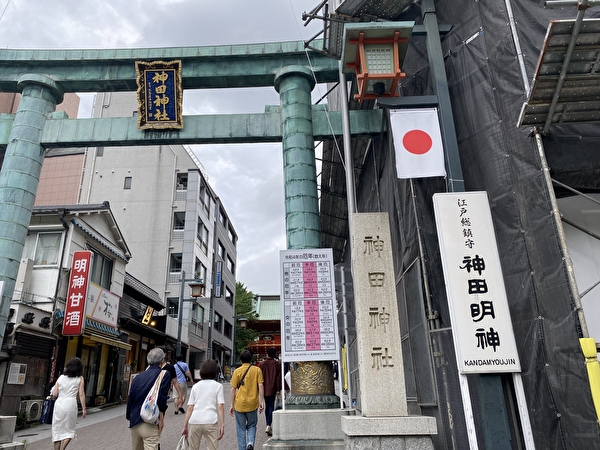「神田明神」
Do you know about Japanese shrines? Kanda Myojin has a history of almost 1,300 years, sitting in Edo Tokyo. At 4T-AMKY, Teachers and Students write about Japanese culture, food, history, many spots to visit, and other stuff. Enjoy reading and knowing about deeper Japanese culture!
Kanda Myojin
Main attraction
Kanda Myojin was founded in 730 by Makandaomi, a descendant of the Izumo clan and the deity Ohonamuchi no Mikoto, in present-day Otemachi, in Chiyoda Ward, Tokyo. In 1616, the shrine was relocated to its current location (Sotokanda, in Chiyoda Ward, Tokyo), which was a place to ward off the devil’s gate of Edo Castle, and the shrine was built by the Edo shogunate.
In the Edo era (1603-1867), it was popular as the general guardian of Edo. Even today it is known as the general guardian of 108 town societies, including Kanda, Nihonbashi, Akihabara, Otemachi, Marunouchi, and Tsukiji. In the Meiji era (1868-1912), the shrine’s name was changed from Kanda Myojin to Kanda Shrine.
As you walk through the Torii gate of Kanda Myojin, you will be overwhelmed by the magnificent Zuishinmon Gate in front of you. Zuishinmon Gate was rebuilt in 1975 to commemorate the 50th anniversary of Emperor Showa’s accession to the throne. The gate is a two-story structure of total hinoki cypress construction, with a glossy vermilion-lacquered finish.

In 1923, the Great Kanto Earthquake burned down the main hall of the shrine. In 1934, it was reconstructed with a steel-framed concrete structure, all painted in vermilion lacquer, which was innovative at the time. It was so sturdy that it survived the Tokyo Air Raid. In 2003, it was designated as a national tangible cultural property to commemorate the 400th anniversary of the founding of Edo.
The large komainu (guardian dogs) in front of the main hall are Showa-era komainu built when the main hall was completed. I was very impressed by the way it welcomed us, facing straight ahead with its back to the main hall. Its appearance also seemed more like a dog than a Shishi, which was unusual and also somehow familiar.

And what caught my attention most of all was the Shishiyama (Shishi Mountain) on the right side of the main hall. The explanatory board said it was a stone Shishi. Both the Japanese and English texts were clear and concise, so I have included them here as they are.

“This stone sculpture is one of the few remaining stone sculptures in Chiyoda City from the Edo Period. It is said it was made by the master stonemason Ishikiri Tobe from Shimotsuke (current-day Tochigi Prefecture) in the Kyoho Era (1716-1735). Records show the associates of a money-exchange shop dedicated a load of stone to Kanda Jinja Shrine in November 1862.
The composition shows 3 stone lions, the parent lions looking at the lion cub pushed down below. Meanwhile, what survived from the Edo Period was the lion couple only, the lion cub and the lion rock being lost in the Great Kanto Earthquake of 1923, but in 1989 it was rebuilt to commemorate the enthronement of His Majesty the Emperor.”

When I once saw the lava Shishi mountain at Hiratsuka Shrine in Kita Ward, I had never seen it before! I was amazed. This stone Shishi was quite tall and very large Shishi mountain. Again, I had never seen it before! I was surprised.
「神田明神」
主な見所
神田明神は730年に出雲氏族で大己貴命(おおなむちのみこと)の子孫・真神田臣(まかんだおみ)により現在の東京都千代田区大手町に創建されました。1616年に江戸城の表鬼門除けにあたる現在の地(東京都千代田区外神田)に遷座し、江戸幕府により社殿が造営されました。
江戸時代には江戸総鎮守として親しまれ、現在でも神田、日本橋、秋葉原、大手町、丸の内、築地など108町会の総氏神として知られています。明治時代には社名を神田明神から神田神社に改称しています。
神田明神の鳥居をくぐり歩いていくと、正面に見える壮大な随神門に圧倒されます。随神門は、1975年(昭和50年)に昭和天皇の御即位50年記念として再建されました。総檜造りの2階建てで、朱塗りの艶やかな門です
1923年(大正12年)に関東大震災により社殿は焼失しました。1934年(昭和9年)に、当時としては画期的な鉄骨鉄筋コンクリート、総朱漆塗の社殿が再建されました。とても頑丈で東京大空襲をも耐え抜いたそうです。2003年には江戸開府400年を記念して国の有形文化財に指定されました。
本殿の正面にいる大きな狛犬は、本殿が竣工された時に造られた昭和の狛犬です。本殿を背にして真正面を向いて出迎えてくれる姿が大変印象的でした。その姿も獅子というよりは犬に近い感じがして、珍しくもあり、どこか親しみやすい感じを受けました。
そして、何より目を引いたのは本殿右手脇の獅子山です。説明版には石獅子とありました。日本文、英文共に簡潔で明瞭な説明がありましたのでそのまま掲載します。
「この石獅子は、区内に残る数少ない江戸期の石造物のひとつです。享保年間(1716~1735)に、下野(現在の栃木県)の名工・石切藤兵衛(いしきりとうべい)が作ったものといわれています。1862年(文久2年)11月に両替屋仲間が石を積んで神田神社へ奉納したという記録があります。
3頭の石獅子は、親獅子が谷底へ突き落した子獅子を見る構図になっています。このうち江戸期以来のものは夫婦2頭のみで、子獅子と獅子山は1923年(大正12年)の関東大震災で失われ、1989年(平成元年)に天皇即位を記念して再建されました」
以前に北区にある平塚神社の溶岩造りの獅子山を見たときは、初めて見た!と驚きました。この石獅子は、かなり高さがありとても大きな獅子山でしたので、またしても、初めて見た!とびっくりしました。
Ikuyo.K.






